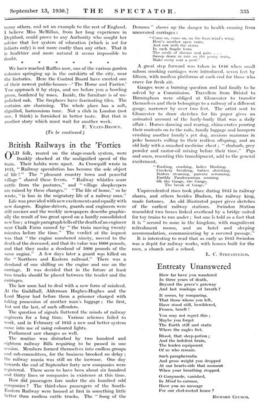British Railways in the 'Forties
OLD folk, reared on the stage-coach system, were frankly shocked at the undignified speed of the train. Their habits were upset. As Crowquill wrote in 1815, "Railway speculation has become the sole object of life ! " The " pleasant country town and peaceful village " shared these fevers. " Railway whistles scare cattle from the pastures," and " village shopkeepers are ruined by these changes." "The life of home," so he wrote, "is lost in the migratory life of a railway man."
Life was provided with new excitements and equally with new dangers. Engine-drivers, guards and engineers were still novices and the weekly newspapers describe graphic- ally the result of too great speed on a hardly consolidated new line ; a tragic paragraph tells of the death of an engineer near Chalk Farm caused by " the train moving twenty minutes before the time." The verdict at the inquest was that " the engine numbered ninety, moved to the death of the deceased, and that its value was 1000 pounds, and that they make a deodand of 1000 pounds of the same engine." A few days later a guard was killed on the " Northern and Eastern railroad." There was a deodand of one shilling on the engine and one on the carriage. It was decided that in the future at least two trucks should be placed between the tender and the carriages.
The law soon had to deal with a new form of misdeed. At the Guildhall, Alderman Hughes-Hughes and the Lord Mayor had before them a prisoner charged with taking possession of another man's luggage ; the first, but not the last, of such offenders.
The question of signals fluttered the minds of railway engineers for a long time. Various schemes failed to work, and in February of 1845 a new and better system came into use of using coloured lights.
Parliament saw changes as well.
The routine was disturbed by two hundred and eighteen railway Bills requiring to be passed in one session. Members formed themselves into endless groups and sub-committees, for the business brooked no delay ; the railway mania was still on the increase. One day towards the end of September forty new companies were registered. There seem to have been about six hundred and thirty lines or companies in existence at this time.
How did passengers fare under the six hundred odd companies ? The third-class passengers of the South- Eastern Railway were housed at first in something little better than roofless cattle trucks. The " Song of the Demons " -shows up the danger to health ensuing from uncovered carriages :
" Como on, come on, on the frost-wind's wing, Hero's another open train, And sow with the storm In each fragile form Tho seeds of disease and pain. . . .
Sweep down in rain on the penny train, Make every seat a pool."
A great step forward was taken in 1846 when small saloon smoking carriages were introduced, seven feet by fifteen, with roofless platforms at each end for those who crave for fresh air.
Gauges were a burning question and had finally to be solved by a Commission. Travellers front Bristol to Birmingham were obliged at Gloucester to transfer themselves and their belongings to a railway of a different gauge, narrower by over two feet. The artist sent to Gloucester to draw sketches for his paper gives an animated account of the hurly-burly that was a daily affair : Horses dancing and rearing, china-crates pouring their contents on to the rails, family luggage and hampers crushing another family's pet dog, anxious mammas in poke bonnets calling to their restless offspring, and an old lady with a smashed medicine chest; " rhubarb, grey powder and castor-oil mixing before their time." Pigs and oxen, resenting this transhipment, add to the general excitement.
" Rushing, crushing, ladies blushing, Crockery breaking, babies shrieking, Boilers steaming, parents screaming, Earthly Pandemonium seeming. Oh the Gauge, the Gauge, The break of Gauge."
• Unprecedented rises took place during 1845 in railway shares, and others besides Hudson, the railway king, made fortunes. An old illustrated paper gives sketches of the earliest railway stations. Swindon Station resembled two boxes linked overhead by a bridge suited for toy trains to run under ; but one is told as a fact that it is " second to none in the kingdom, with magnificent refreshment rooms, and an hotel and sleeping accommodation, communicating by a covered passage."
It is interesting to read that as early as 1845 Swindon was a depot for railway works, with houses built for the men, a church and a school.
L. C. STREATFEILD.










































 Previous page
Previous page